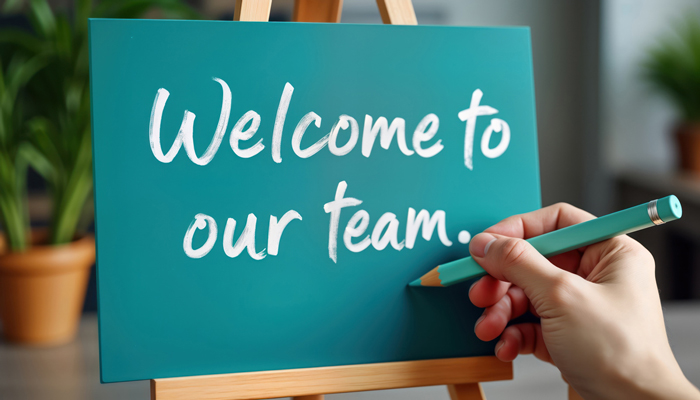
BY AMY COOLEY
In the chauffeured transportation world, we’re used to moving fast—book the trip, assign the run, handle the curveballs, and keep things rolling. But there’s one area where rushing can do real harm: onboarding.We all know how costly turnover is. So why do so many operators still treat onboarding like a quick checklist instead of a long-term investment? The truth is, the way you welcome a new team member into your company sets the tone for everything that follows—performance, communication, accountability, and retention.
Whether you’re bringing on a chauffeur, a dispatcher, or a CSR, it’s time to stop thinking of onboarding as “orientation” and start treating it as your first opportunity to lead well.
First Impressions Matter—Even in a Driver’s Seat
Think about your last new hire. Did they show up on day one to a warm welcome, a clean and organized work area, and a clear schedule? Or did they wait around while someone scrambled to find training materials or logins?
It doesn’t take much for a new employee to wonder, “Did they forget I was starting today?”
 First impressions aren’t just about professionalism, they’re about trust. A smooth, structured start tells your new hire, “We’re glad you’re here, and we’re ready for you.” That message goes a long way toward building commitment early.
First impressions aren’t just about professionalism, they’re about trust. A smooth, structured start tells your new hire, “We’re glad you’re here, and we’re ready for you.” That message goes a long way toward building commitment early. What Effective Onboarding Looks Like
It doesn’t have to be complicated or corporate. Onboarding should be hands-on, clear, and aligned with how the job really works. Here’s what that looks like:
1. Assign a point person.
Even in small shops, no one should start without knowing who to go to with questions. Whether it’s the chauffeur manager, dispatcher lead, or shop supervisor, assigning a point of contact keeps people from falling through the cracks.
2. Create a basic plan.
Map out the first few days—or even weeks. This doesn’t have to be rigid, but it should be intentional. For example, here’s what a quick plan for a new chauffeur could look like:
• Day 1: Paperwork, uniforms, facility tour, intro to team
• Day 2: Shadow a senior chauffeur for a “day in the life,” including a ride-along
OR
• Week 1: Vehicle training, dispatch system basics, review of expectations
3. Use industry-specific examples.
Generic customer service training won’t cut it. A CSR needs to know how to handle wedding planners and delayed flights. A chauffeur needs to understand how to respond when a client insists they were told there’d be bottled water, and it’s not in the car. Onboarding should teach your way of handling these moments.
Onboarding Essentials Checklist
Use this list to make sure every new hire gets off to a strong start—no matter the role.
Welcome Email or Call Before Day One — Confirm their start date, time, dress code, and where to report.
Assigned Point Person — Someone they can go to with questions—ideally a lead or supervisor.
Day-One Schedule — Includes paperwork, tour, introductions, and basic expectations.
Hands-On Training Plan — Role-specific training (e.g., vehicle features, dispatch tools, phone scripts).
Walk Through of Required Tech/Apps — Logins and how-to’s for dispatch software, GPS apps, pre-trip inspection tools, timesheets, etc.
Regulatory & Compliance Basics — DOT files, safety protocols, drug/alcohol policy, pre/post-trip inspections, uniform standards.
Clear Expectations — Outline job duties, appearance standards, communication norms, and who to contact in various scenarios.
Ride-Alongs or Shadowing — Let them see how your team handles real-world situations.
30-Day Check-In — Ask for feedback, answer lingering questions, and begin layering in performance accountability.
Encouragement & Recognition — Reinforce what they’re doing well early and often.
A little preparation on your end makes a lasting impression—and a big difference in long-term success.
4. Cover your culture. Use this list to make sure every new hire gets off to a strong start—no matter the role.
Welcome Email or Call Before Day One — Confirm their start date, time, dress code, and where to report.
Assigned Point Person — Someone they can go to with questions—ideally a lead or supervisor.
Day-One Schedule — Includes paperwork, tour, introductions, and basic expectations.
Hands-On Training Plan — Role-specific training (e.g., vehicle features, dispatch tools, phone scripts).
Walk Through of Required Tech/Apps — Logins and how-to’s for dispatch software, GPS apps, pre-trip inspection tools, timesheets, etc.
Regulatory & Compliance Basics — DOT files, safety protocols, drug/alcohol policy, pre/post-trip inspections, uniform standards.
Clear Expectations — Outline job duties, appearance standards, communication norms, and who to contact in various scenarios.
Ride-Alongs or Shadowing — Let them see how your team handles real-world situations.
30-Day Check-In — Ask for feedback, answer lingering questions, and begin layering in performance accountability.
Encouragement & Recognition — Reinforce what they’re doing well early and often.
A little preparation on your end makes a lasting impression—and a big difference in long-term success.
Every company has its own way of doing things. Talk about it, don’t just assume people will pick it up. What’s your policy on late runs? Who gets notified when there’s a vehicle issue? How do you expect chauffeurs to communicate with dispatch? Spell it out.
Avoid a “Sink or Swim” Scenario
Too often, especially during busy seasons, we throw new people into the deep end and hope they figure it out. But here’s the thing: when someone stumbles through their first few weeks, they rarely catch up. They may not say anything— they might even smile and nod—but inside, they’re losing confidence and faith in your operation.
Instead, give them a runway. Let them build competence gradually. Offer feedback early and often—not just when something goes wrong.
Don’t Stop at Week One
Onboarding isn’t just about the first shift. The 30-day mark is a great time to check in.
• How are they feeling about the role?
• What questions do they still have?
• Do they feel equipped to succeed?
This is also the time to start layering in accountability. Once someone knows the expectations, it’s fair—and important—to start holding them to them. But those expectations should be clearly stated, taught, and reinforced. That’s what good onboarding does.
Bonus Tip: Onboarding Helps You, Too
Here’s something operators don’t always consider: onboarding isn’t just for the employee—it’s for the company. The better your onboarding, the faster a new team member becomes productive, reliable, and client-ready. You reduce the risk of early turnover. You save yourself the time, energy, and cost of re-hiring. And you gain someone who feels connected to your mission and ready to represent your brand.
Final Thoughts
You don’t need a whole separate training department to onboard well. You just need a plan, a little structure, and a commitment to setting your people up to succeed. The next time you bring someone new on board, think of it as more than a hire; it’s the beginning of a relationship. Start it strong, and you’ll both benefit in the long run. [CD0725]
Amy Cooley is HR Leaderfor The LMC Groups. She can be reached at




